Advertisements
Advertisements
प्रश्न
Find the time period of the motion of the particle shown in figure . Neglect the small effect of the bend near the bottom.
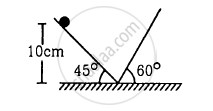
उत्तर
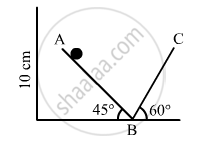
Let t1 and t2 be the time taken by the particle to travel distances AB and BC respectively.
Acceleration for part AB, a1 = g sin 45°
The distance travelled along AB is s1.
\[\therefore s_1 = \frac{0 . 1}{\sin 45^\circ} = 2 m\]
Let v be the velocity at point B, and
u be the initial velocity.
Using the third equation of motion, we have:
v2 − u2 = 2a1s1
\[\Rightarrow v^2 = 2 \times g \sin 45^\circ\times \frac{0 . 1}{\sin 45^\circ} = 2\]
\[ \Rightarrow v = \sqrt{2} m/s\]
\[As v = u + a_1 t_1 \]
\[ \therefore t_1 = \frac{v - u}{a_1}\]
\[ = \frac{\sqrt{2} - 0}{\frac{g}{\sqrt{2}}}\]
\[ = \frac{2}{g} = \frac{2}{10} = 0 . 2 \sec \ ( g = 10 {ms}^{- 2} )\]
For the distance BC,
Acceleration, a2 =\[-\]gsin 60°
\[\text { Initial velocity }, u = \sqrt{2} \]
\[ v = 0\]
\[ \therefore \text { time period }, t_2 = \frac{0 - \sqrt{2}}{- \frac{g}{\left( 3\sqrt{2} \right)}} = \frac{2\sqrt{2}}{\sqrt{3}g}\]
\[ = \frac{2 \times \left( 1 . 414 \right)}{\left( 1 . 732 \right) \times 10} = 0 . 163 s\]
Thus, the total time period, t = 2(t1 + t2) = 2 (0.2 + 0.163) = 0.73 s
APPEARS IN
संबंधित प्रश्न
A copper metal cube has each side of length 1 m. The bottom edge of the cube is fixed and tangential force 4.2x108 N is applied to a top surface. Calculate the lateral displacement of the top surface if modulus of rigidity of copper is 14x1010 N/m2.
Answer in brief:
Derive an expression for the period of motion of a simple pendulum. On which factors does it depend?
The length of the second’s pendulum in a clock is increased to 4 times its initial length. Calculate the number of oscillations completed by the new pendulum in one minute.
Two bodies A and B of equal mass are suspended from two separate massless springs of spring constant k1 and k2 respectively. If the bodies oscillate vertically such that their maximum velocities are equal, the ratio of the amplitude of A to that of B is
The position, velocity and acceleration of a particle executing simple harmonic motion are found to have magnitude 2 cm, 1 m s−1 and 10 m s−2 at a certain instant. Find the amplitude and the time period of the motion.
Consider a simple harmonic motion of time period T. Calculate the time taken for the displacement to change value from half the amplitude to the amplitude.
A spring stores 5 J of energy when stretched by 25 cm. It is kept vertical with the lower end fixed. A block fastened to its other end is made to undergo small oscillations. If the block makes 5 oscillations each second what is the mass of the block?
A small block of mass m is kept on a bigger block of mass M which is attached to a vertical spring of spring constant k as shown in the figure. The system oscillates vertically. (a) Find the resultant force on the smaller block when it is displaced through a distance x above its equilibrium position. (b) Find the normal force on the smaller block at this position. When is this force smallest in magnitude? (c) What can be the maximum amplitude with which the two blocks may oscillate together?

A particle of mass m is attatched to three springs A, B and C of equal force constants kas shown in figure . If the particle is pushed slightly against the spring C and released, find the time period of oscillation.
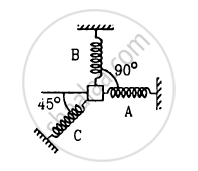
The string the spring and the pulley shown in figure are light. Find the time period of the mass m.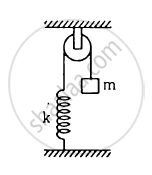
A uniform plate of mass M stays horizontally and symmetrically on two wheels rotating in opposite direction in Figure . The separation between the wheels is L. The friction coefficient between each wheel and the plate is μ. Find the time period of oscillation of the plate if it is slightly displaced along its length and released.

The ear-ring of a lady shown in figure has a 3 cm long light suspension wire. (a) Find the time period of small oscillations if the lady is standing on the ground. (b) The lady now sits in a merry-go-round moving at 4 m/s1 in a circle of radius 2 m. Find the time period of small oscillations of the ear-ring.
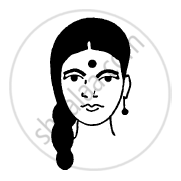
A uniform disc of radius r is to be suspended through a small hole made in the disc. Find the minimum possible time period of the disc for small oscillations. What should be the distance of the hole from the centre for it to have minimum time period?
Which of the following example represent periodic motion?
A freely suspended bar magnet displaced from its N-S direction and released.
Which of the following example represent (nearly) simple harmonic motion and which represent periodic but not simple harmonic motion?
The motion of a ball bearing inside a smooth curved bowl, when released from a point slightly above the lowermost point.
When two displacements represented by y1 = a sin(ωt) and y2 = b cos(ωt) are superimposed the motion is ______.
The equation of motion of a particle is x = a cos (αt)2. The motion is ______.
A person normally weighing 50 kg stands on a massless platform which oscillates up and down harmonically at a frequency of 2.0 s–1 and an amplitude 5.0 cm. A weighing machine on the platform gives the persons weight against time.
- Will there be any change in weight of the body, during the oscillation?
- If answer to part (a) is yes, what will be the maximum and minimum reading in the machine and at which position?
